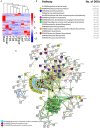The Transcriptome Profiling of Flavonoids and Bibenzyls Reveals Medicinal Importance of Rare Orchid Arundina graminifolia
- PMID: 35812923
- PMCID: PMC9260279
- DOI: 10.3389/fpls.2022.923000
The Transcriptome Profiling of Flavonoids and Bibenzyls Reveals Medicinal Importance of Rare Orchid Arundina graminifolia
Abstract
Orchids are very important flowering plants that spend long juvenile phases before flowering. Along with aesthetic importance, they are rich sources of medicinal components. However, their long reproductive cycle is the major hurdle to study the medicinal efficacy. Arundina graminifolia is a rare orchid that grows fast, unlike other orchids, and this characteristic makes it an ideal plant to study the medicinal enrichment of orchids. Therefore, this study presents the identification of important medicinal components in various parts of A. graminifolia. Transcriptome analysis was performed for five stages (FD1-FD5) of flower development and four tissue types (mature flower, silique, root, and leaf) to ascertain genetic regulators of flavonoids and bibenzyls. Most of the genes showed the highest expression in roots as compared with other tissues. Weighted gene coexpression network analysis (WGCNA) was performed to identify the coexpression modules and the candidate genes involving biosynthesis pathways of these chemicals. MEyellow module contained the highly coexpressed genes. Moreover, the concentrations of phenylpropanoid, bibenzyls, and flavone were ascertained through high-performance liquid chromatography-tandem mass spectrometry (HPLC-MS/MS). Phenylpropanoid and bibenzyl were comparatively high in the leaf, while flavone showed a high concentration in the stem. The selected candidate genes [bibenzyl biosynthesis (BIBSY212), CYP84A1, CYP73A4, 4CLL7, UGT88B1, UGT73C3, anthocyanin synthase (ANS), phenylalanine ammonia-lyase (PAL), flavanone synthase FLS, and CHS8] were validated through quantitative real-time PCR (qRT-PCR). Most of these genes showed high expression in leaf and root as compared with other tissue. Therefore, the presence of bibenzyls and flavonoids in different parts of A. graminifolia and their molecular regulators can provide a quick source to decipher the medicinal efficacy of orchids.
Keywords: Arundina graminifolia; HPLC-MS/MS; WGCNA; medicinal constituents; model orchid.
Copyright © 2022 Ahmad, Gao, Wei, Lu, Zhu and Yang.
Conflict of interest statement
The authors declare that the research was conducted in the absence of any commercial or financial relationships that could be construed as a potential conflict of interest.
Figures





Similar articles
-
Genetic insights into the regulatory pathways for continuous flowering in a unique orchid Arundina graminifolia.BMC Plant Biol. 2021 Dec 10;21(1):587. doi: 10.1186/s12870-021-03350-6. BMC Plant Biol. 2021. PMID: 34893019 Free PMC article.
-
Stage Specificity, the Dynamic Regulators and the Unique Orchid Arundina graminifolia.Int J Mol Sci. 2021 Oct 10;22(20):10935. doi: 10.3390/ijms222010935. Int J Mol Sci. 2021. PMID: 34681593 Free PMC article.
-
Transcriptional Cascade in the Regulation of Flowering in the Bamboo Orchid Arundina graminifolia.Biomolecules. 2021 May 21;11(6):771. doi: 10.3390/biom11060771. Biomolecules. 2021. PMID: 34063940 Free PMC article.
-
Phytochemistry and pharmacological activities of Arundina graminifolia (D.Don) Hochr. And other common Orchidaceae medicinal plants.J Ethnopharmacol. 2021 Aug 10;276:114143. doi: 10.1016/j.jep.2021.114143. Epub 2021 Apr 28. J Ethnopharmacol. 2021. PMID: 33932509 Review.
-
A Walk Through the Maze of Secondary Metabolism in Orchids: A Transcriptomic Approach.Front Plant Sci. 2022 Apr 29;13:837563. doi: 10.3389/fpls.2022.837563. eCollection 2022. Front Plant Sci. 2022. PMID: 35574139 Free PMC article. Review.
Cited by
-
A Fragment Insertion of AgDFR Results in a White Flower Phenotype in Arundina graminifolia (Orchidaceae).Plants (Basel). 2025 May 31;14(11):1680. doi: 10.3390/plants14111680. Plants (Basel). 2025. PMID: 40508354 Free PMC article.
-
Detection of a bibenzyl core scaffold in 28 common mangrove and associate species of the Indian Sundarbans: potential signature molecule for mangrove salinity stress acclimation.Front Plant Sci. 2024 Jan 16;14:1291805. doi: 10.3389/fpls.2023.1291805. eCollection 2023. Front Plant Sci. 2024. PMID: 38293624 Free PMC article.
-
Comparative transcriptomics and proteomics analysis of the symbiotic germination of Paphiopedilum barbigerum with Epulorhiza sp. FQXY019.Front Microbiol. 2024 Mar 18;15:1358137. doi: 10.3389/fmicb.2024.1358137. eCollection 2024. Front Microbiol. 2024. PMID: 38562471 Free PMC article.
-
Transcriptomic and protein-protein interaction network analyses of the molecular mechanisms underlying the mycorrhizal interaction in Cypripedium macranthos var. rebunense.Front Plant Sci. 2025 Jul 10;16:1597154. doi: 10.3389/fpls.2025.1597154. eCollection 2025. Front Plant Sci. 2025. PMID: 40708584 Free PMC article.
-
The Integrated mRNA and miRNA Approach Reveals Potential Regulators of Flowering Time in Arundina graminifolia.Int J Mol Sci. 2023 Jan 15;24(2):1699. doi: 10.3390/ijms24021699. Int J Mol Sci. 2023. PMID: 36675213 Free PMC article.
References
-
- Ahmad S., Lu C., Wei Y., Gao J., Jin J., Zheng C., et al. . (2022). The de novo transcriptome identifies important zinc finger signatures associated with flowering in the orchid Arundina graminifolia. Sci. Hortic. 291, 110572. 10.1016/j.scienta.2021.110572 - DOI
LinkOut - more resources
Full Text Sources

